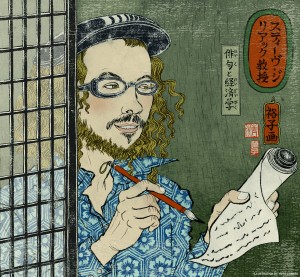Invisible hand;
mother of inflated hope,
mistress of despair!
Haiku economics first got off the ground in 2001, when I introduced the subject to hundreds of students I was teaching at the Georgia Institute of Technology.
My idea of putting the principles of economics together with the principles of haiku was for the mutual study and benefit of both arts and sciences. Haiku economics was controversial at first, even bizarre, some said. The economists were initially skeptical (I am being generous) but students took to “haiku economics” almost instantly. In fact in 2002, and again in 2003, students at Georgia Tech surprised me with – as Steve Levitt has kindly noted at Freakonomics – two big teaching prizes and poems of their own.
Bashō himself would not be surprised, or so I’ve argued. I tell the story in an essay, “Haiku Economics: Money, Metaphor, and the Invisible Hand,” which I published in 2011 in Poetry magazine. According to the editors of Poetry, my essay was one of the most-read articles in 2011, and is now the most-read article they’ve published in “The View from Here” column. I can’t complain given that previous contributors include Richard Rorty, Christopher Hitchens, Lynda Barry, Neko Case, and the legendary basketball coach and poet, John Wooden (yes, he was a poet).
The first publication of “Haiku Economics” appeared in 2002, in the journal Rethinking Marxism, which was then edited by David Ruccio, Stephen Cullenberg, and Jack Amariglio. (I did not mean to misspell Alan Greenspan’s name; my apologies. But at least the syllable count is the same!) In 2005 I published in the same journal, Haiku Economics No. 2. It wasn’t my best work. But I was inventing something, after all, and invention takes time. A few years later, as I was writing the essay for Poetry magazine, I found comfort in the following haiku (Ziliak, Poetry 197 (4), p. 315):
Window reflection – / The baby sparrow sitting, / listening to glass
Haiku economics went global after feature articles in The Wall Street Journal (Dec. 2008; and here: July 2009), The Chronicle of Higher Education (May 2009), National Public Radio (May 2009), Poetry (January 2011), Boston Public Radio (January 2011), and The Economist (January 2011; and here, in The Economist’s Prospero column). All over the world one can now find haiku-economics writing competitions and, so far as we know, Jeremy Bentham has not yet risen from the dead.
To learn more about the history, theory, and practice of haiku economics, the best place to start is an article called “Haiku Economics: Little Teaching Aids for Big Economic Pluralists” which was published in 2009 in the International Journal of Pluralism and Economics Education.
If you’re curious about haiku economics dialogue – how to speak economics in haiku form – check out a piece I did with Steve Kolowich and The Chronicle of Higher Education, “Verses of Economy” (2009).
Here’s a small sample of other reactions I’ve gotten to the increasingly popular art form:
Mary Pilon, Wall Street Journal (and here)
More Intelligent Life (The Economist)
NPR, Planet Money Blog (Chana Joffe-Walt)
NPR, “On Point” (Tom Ashcroft)
Editors, Poetry magazine (Christian Wiman and Don Share)
Poetry Foundation, Harriet Blog
Tim Harford (and here)
Erica Alini, Wall Street Journal (Real Time Economics Blog)
Editors, Wall Street Journal (Real Time Economics Blog)
Freakonomics (and here)
The Atlantic (Andrew Sullivan “Daily Dish”)
Better Living through Beowulf (Robin Bates)


